MITSUBISHI L200 2017 Owner's Manual (in English)
Manufacturer: MITSUBISHI, Model Year: 2017, Model line: L200, Model: MITSUBISHI L200 2017Pages: 426, PDF Size: 14.12 MB
Page 171 of 426
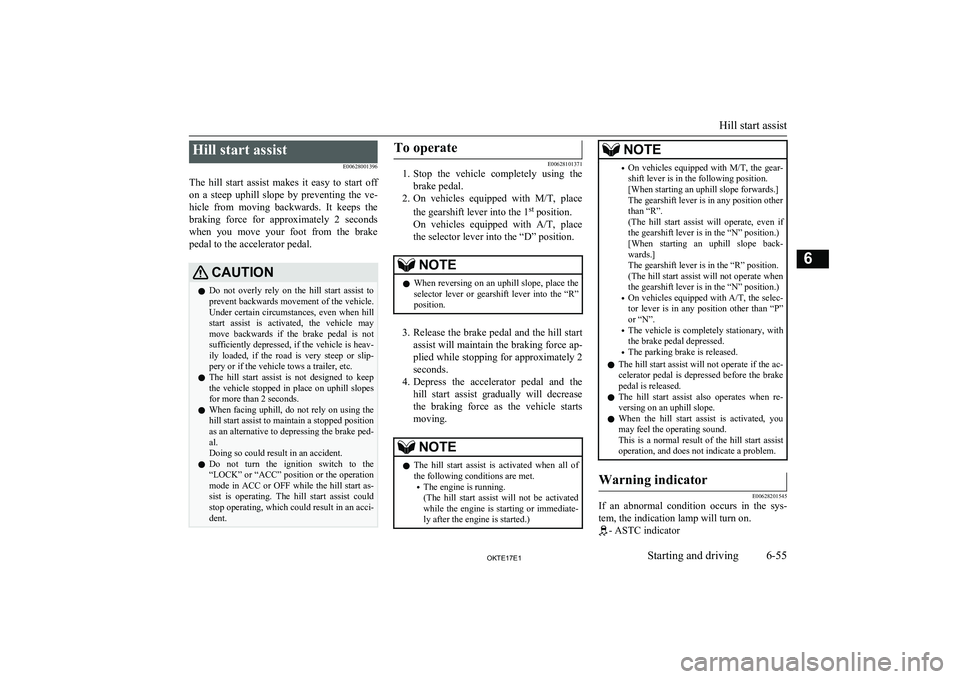
Hill start assistE00628001396
The hill start assist makes it easy to start off on a steep uphill slope by preventing the ve-
hicle from moving backwards. It keeps the
braking force for approximately 2 seconds when you move your foot from the brake
pedal to the accelerator pedal.CAUTIONl Do not overly rely on the hill start assist to
prevent backwards movement of the vehicle. Under certain circumstances, even when hill
start assist is activated, the vehicle may
move backwards if the brake pedal is not sufficiently depressed, if the vehicle is heav-
ily loaded, if the road is very steep or slip- pery or if the vehicle tows a trailer, etc.
l The hill start assist is not designed to keep
the vehicle stopped in place on uphill slopes for more than 2 seconds.
l When facing uphill, do not rely on using the
hill start assist to maintain a stopped position as an alternative to depressing the brake ped-
al.
Doing so could result in an accident.
l Do not turn the ignition switch to the
“LOCK” or “ACC” position or the operation
mode in ACC or OFF while the hill start as- sist is operating. The hill start assist couldstop operating, which could result in an acci-
dent.To operate
E00628101371
1. Stop the vehicle completely using the
brake pedal.
2. On vehicles equipped with M/T, place
the gearshift lever into the 1 st
position.
On vehicles equipped with A/T, place
the selector lever into the “D” position.
NOTEl When reversing on an uphill slope, place the
selector lever or gearshift lever into the “R”
position.
3. Release the brake pedal and the hill start
assist will maintain the braking force ap-
plied while stopping for approximately 2 seconds.
4. Depress the accelerator pedal and the
hill start assist gradually will decrease the braking force as the vehicle startsmoving.
NOTEl The hill start assist is activated when all of
the following conditions are met.
• The engine is running.
(The hill start assist will not be activated
while the engine is starting or immediate-
ly after the engine is started.)NOTE• On vehicles equipped with
M/T, the gear-
shift lever is in the following position.
[When starting an uphill slope forwards.]
The gearshift lever is in any position other
than “R”.
(The hill start assist will operate, even if the gearshift lever is in the “N” position.)
[When starting an uphill slope back-
wards.]
The gearshift lever is in the “R” position.
(The hill start assist will not operate when
the gearshift lever is in the “N” position.)
• On vehicles equipped with
A/T, the selec-
tor lever is in any position other than “P” or “N”.
• The vehicle is completely stationary, with
the brake pedal depressed.
• The parking brake is released.
l The hill start assist will not operate if the ac-
celerator pedal is depressed before the brake pedal is released.
l The hill start assist also operates when re-
versing on an uphill slope.
l When the hill start assist is activated, you
may feel the operating sound.
This is a normal result of the hill start assist operation, and does not indicate a problem.Warning indicator
E00628201545
If an abnormal condition occurs in the sys-
tem, the indication lamp will turn on.
- ASTC indicator
Hill start assist
6-55OKTE17E1Starting and driving6
Page 172 of 426
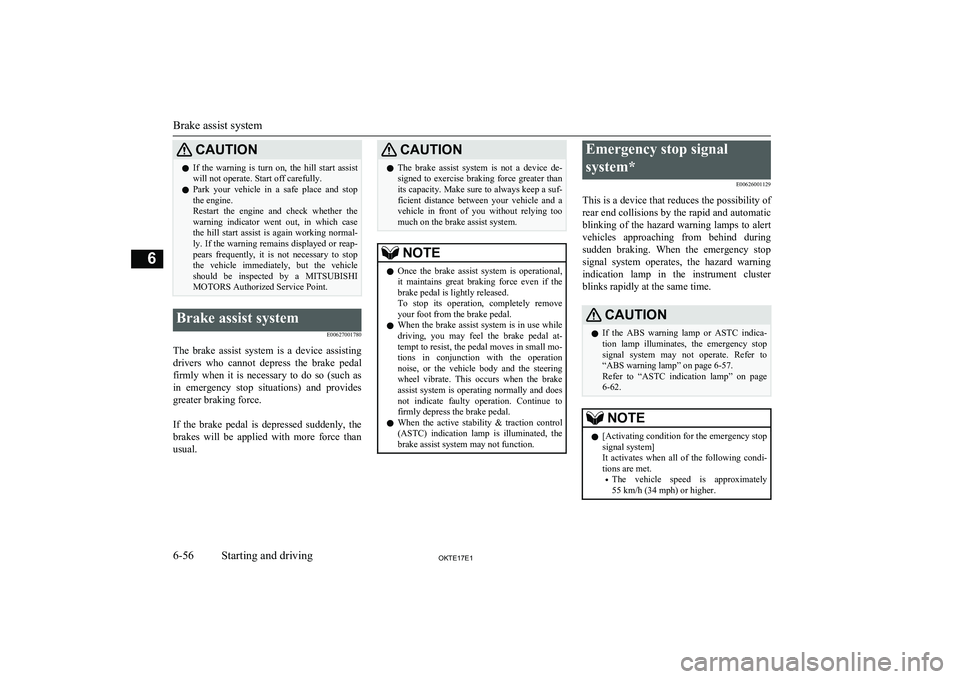
CAUTIONlIf the warning is turn on, the hill start assist
will not operate. Start off carefully.
l Park your vehicle in a safe place and stop
the engine.
Restart the engine and check whether the warning indicator went out, in which case
the hill start assist is again working normal- ly. If the warning remains displayed or reap-
pears frequently, it is not necessary to stop
the vehicle immediately, but the vehicle
should be inspected by a MITSUBISHI
MOTORS Authorized Service Point.Brake assist system
E00627001780
The brake assist system is a device assistingdrivers who cannot depress the brake pedalfirmly when it is necessary to do so (such as
in emergency stop situations) and provides
greater braking force.
If the brake pedal is depressed suddenly, the brakes will be applied with more force thanusual.
CAUTIONl The brake assist system is not a device de-
signed to exercise braking force greater than its capacity. Make sure to always keep a suf-
ficient distance between your vehicle and a
vehicle in front of you without relying too much on the brake assist system.NOTEl Once the brake assist system is operational,
it maintains great braking force even if the
brake pedal is lightly released.
To stop its operation, completely remove
your foot from the brake pedal.
l When the brake assist system is in use while
driving, you may feel the brake pedal at-
tempt to resist, the pedal moves in small mo- tions in conjunction with the operation
noise, or the vehicle body and the steering wheel vibrate. This occurs when the brake
assist system is operating normally and does not indicate faulty operation. Continue to
firmly depress the brake pedal.
l When the active stability & traction control
(ASTC) indication lamp is illuminated, the
brake assist system may not function.Emergency stop signal
system* E00626001129
This is a device that reduces the possibility of rear end collisions by the rapid and automatic blinking of the hazard warning lamps to alert
vehicles approaching from behind during sudden braking. When the emergency stop
signal system operates, the hazard warning indication lamp in the instrument cluster
blinks rapidly at the same time.CAUTIONl If the ABS warning lamp or ASTC indica-
tion lamp illuminates, the emergency stopsignal system may not operate. Refer to“ABS warning lamp” on page 6-57.
Refer to “ASTC indication lamp” on page
6-62.NOTEl [Activating condition for the emergency stop
signal system]
It activates when all of the following condi-
tions are met.
• The vehicle speed is approximately
55 km/h (34 mph) or higher.
Brake assist system
6-56OKTE17E1Starting and driving6
Page 173 of 426
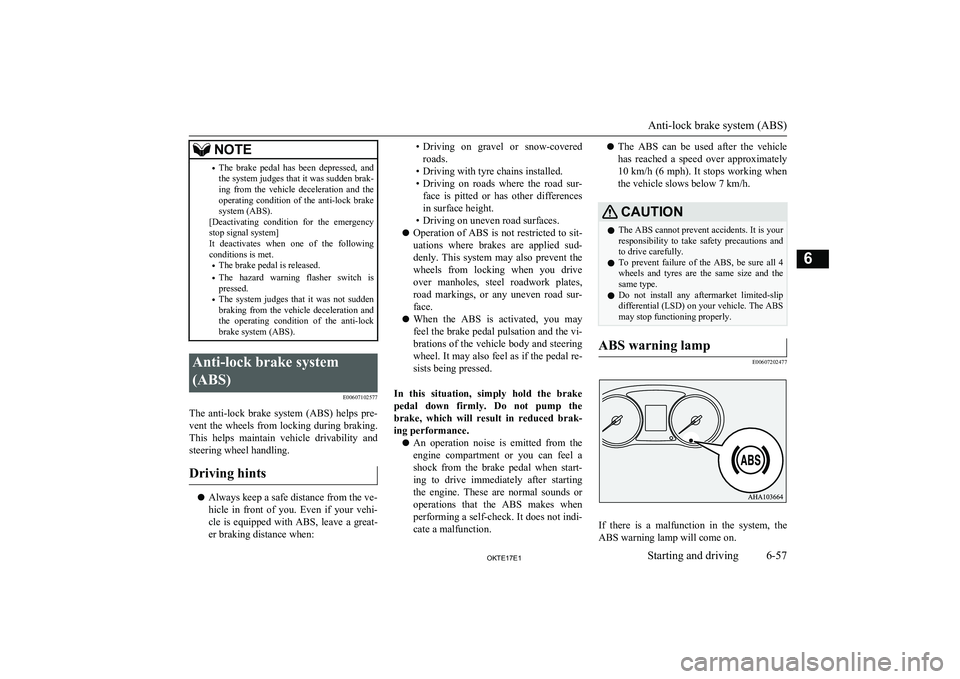
NOTE•The brake pedal has been depressed, and
the system judges that it was sudden brak-
ing from the vehicle deceleration and the operating condition of the anti-lock brake
system (ABS).
[Deactivating condition for the emergency stop signal system]
It deactivates when one of the following conditions is met.
• The brake pedal is released.
• The hazard warning flasher switch is
pressed.
• The system judges that it was not sudden
braking from the vehicle deceleration and
the operating condition of the anti-lock brake system (ABS).Anti-lock brake system
(ABS) E00607102577
The anti-lock brake system (ABS) helps pre-vent the wheels from locking during braking.
This helps maintain vehicle drivability and
steering wheel handling.
Driving hints
l Always keep a safe distance from the ve-
hicle in front of you. Even if your vehi- cle is equipped with ABS, leave a great-
er braking distance when:
• Driving on gravel or snow-covered
roads.
• Driving with tyre chains installed.
• Driving on roads where the road sur-
face is pitted or has other differences in surface height.
• Driving on uneven road surfaces.
l Operation of ABS is not restricted to sit-
uations where brakes are applied sud-denly. This system may also prevent the
wheels from locking when you drive over manholes, steel roadwork plates,
road markings, or any uneven road sur-
face.
l When the ABS is activated, you may
feel the brake pedal pulsation and the vi-
brations of the vehicle body and steering
wheel. It may also feel as if the pedal re- sists being pressed.
In this situation, simply hold the brake
pedal down firmly. Do not pump the
brake, which will result in reduced brak- ing performance.
l An operation noise is emitted from the
engine compartment or you can feel a shock from the brake pedal when start-
ing to drive immediately after starting
the engine. These are normal sounds or operations that the ABS makes whenperforming a self-check. It does not indi-
cate a malfunction.l The ABS can be used after the vehicle
has reached a speed over approximately 10 km/h (6 mph). It stops working when the vehicle slows below 7 km/h.CAUTIONl The ABS cannot prevent accidents. It is your
responsibility to take safety precautions and to drive carefully.
l To prevent failure of the ABS, be sure all 4
wheels and tyres are the same size and the same type.
l Do not install any aftermarket limited-slip
differential (LSD) on your vehicle. The ABS may stop functioning properly.ABS warning lamp
E00607202477
If there is a malfunction in the system, the
ABS warning lamp will come on.
Anti-lock brake system (ABS)
6-57OKTE17E1Starting and driving6
Page 174 of 426
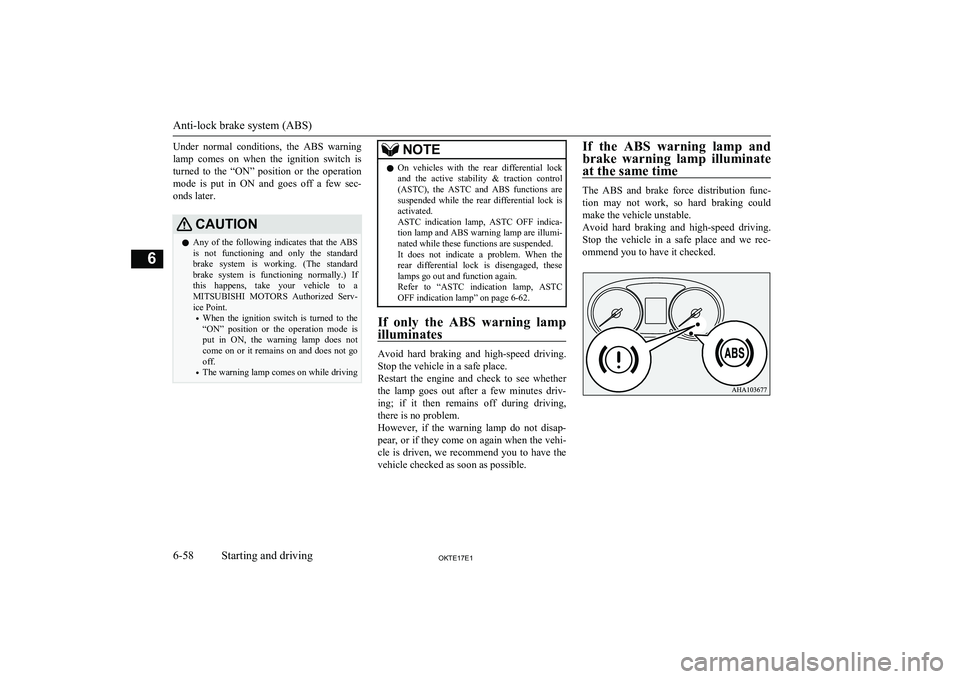
Under normal conditions, the ABS warning
lamp comes on when the ignition switch is turned to the “ON” position or the operation
mode is put in ON and goes off a few sec-
onds later.CAUTIONl Any of the following indicates that the ABS
is not functioning and only the standard
brake system is working. (The standard brake system is functioning normally.) If this happens, take your vehicle to a
MITSUBISHI MOTORS Authorized Serv-
ice Point.
• When the ignition switch is turned to the
“ON” position or the operation mode is put in ON, the warning lamp does notcome on or it remains on and does not go
off.
• The warning lamp comes on while drivingNOTEl On vehicles with the rear differential lock
and the active stability & traction control
(ASTC), the ASTC and ABS functions are suspended while the rear differential lock isactivated.
ASTC indication lamp, ASTC OFF indica-
tion lamp and ABS warning lamp are illumi- nated while these functions are suspended.
It does not indicate a problem. When the
rear differential lock is disengaged, these lamps go out and function again.
Refer to “ASTC indication lamp, ASTC
OFF indication lamp” on page 6-62.
If only the ABS warning lamp
illuminates
Avoid hard braking and high-speed driving.
Stop the vehicle in a safe place.
Restart the engine and check to see whether the lamp goes out after a few minutes driv-
ing; if it then remains off during driving,
there is no problem.
However, if the warning lamp do not disap- pear, or if they come on again when the vehi-cle is driven, we recommend you to have the vehicle checked as soon as possible.
If the ABS warning lamp and
brake warning lamp illuminate at the same time
The ABS and brake force distribution func-tion may not work, so hard braking could
make the vehicle unstable.
Avoid hard braking and high-speed driving.
Stop the vehicle in a safe place and we rec- ommend you to have it checked.
Anti-lock brake system (ABS)
6-58OKTE17E1Starting and driving6
Page 175 of 426
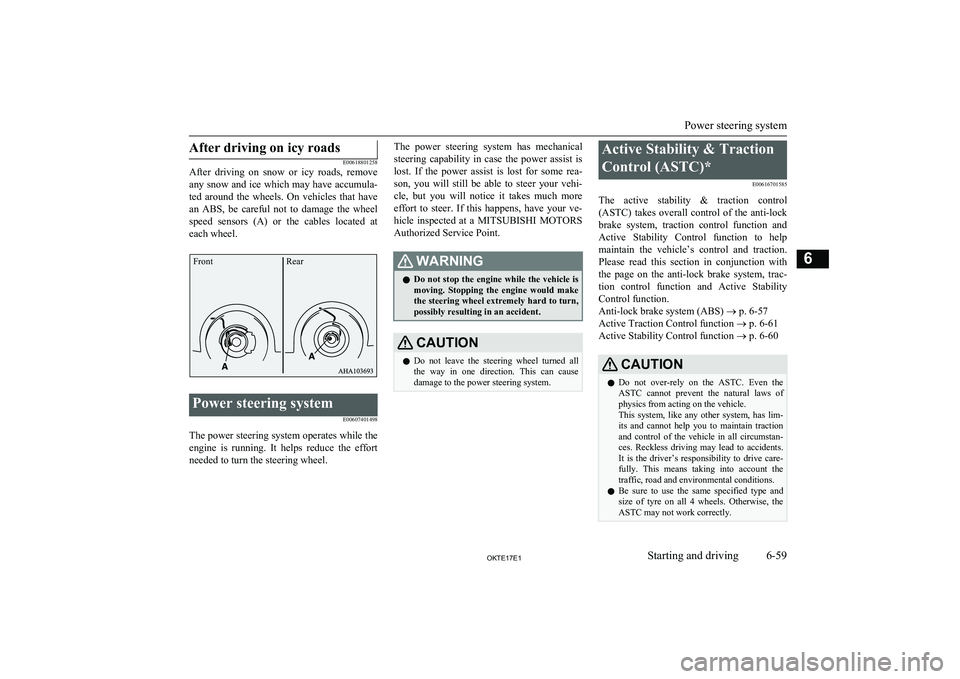
After driving on icy roads
E00618801258
After driving on snow or icy roads, remove
any snow and ice which may have accumula-
ted around the wheels. On vehicles that have
an ABS, be careful not to damage the wheel
speed sensors (A) or the cables located at each wheel.Power steering system
E00607401498
The power steering system operates while the
engine is running. It helps reduce the effort needed to turn the steering wheel.
The power steering system has mechanical
steering capability in case the power assist is lost. If the power assist is lost for some rea-
son, you will still be able to steer your vehi-
cle, but you will notice it takes much more effort to steer. If this happens, have your ve-
hicle inspected at a MITSUBISHI MOTORS
Authorized Service Point.WARNINGl Do not stop the engine while the vehicle is
moving. Stopping the engine would make the steering wheel extremely hard to turn,
possibly resulting in an accident.CAUTIONl Do not leave the steering wheel turned all
the way in one direction. This can causedamage to the power steering system.Active Stability & Traction
Control (ASTC)* E00616701585
The active stability & traction control (ASTC) takes overall control of the anti-lockbrake system, traction control function and Active Stability Control function to help
maintain the vehicle’s control and traction. Please read this section in conjunction with the page on the anti-lock brake system, trac- tion control function and Active Stability
Control function.
Anti-lock brake system (ABS) ® p. 6-57
Active Traction Control function ® p. 6-61
Active Stability Control function ® p. 6-60CAUTIONl Do not over-rely on the ASTC. Even the
ASTC cannot prevent the natural laws of physics from acting on the vehicle.
This system, like any other system, has lim-
its and cannot help you to maintain traction and control of the vehicle in all circumstan- ces. Reckless driving may lead to accidents.
It is the driver’s responsibility to drive care- fully. This means taking into account the
traffic, road and environmental conditions.
l Be sure to use the same specified type and
size of tyre on all 4 wheels. Otherwise, the ASTC may not work correctly.
Power steering system
6-59OKTE17E1Starting and driving6Front Rear
Page 176 of 426
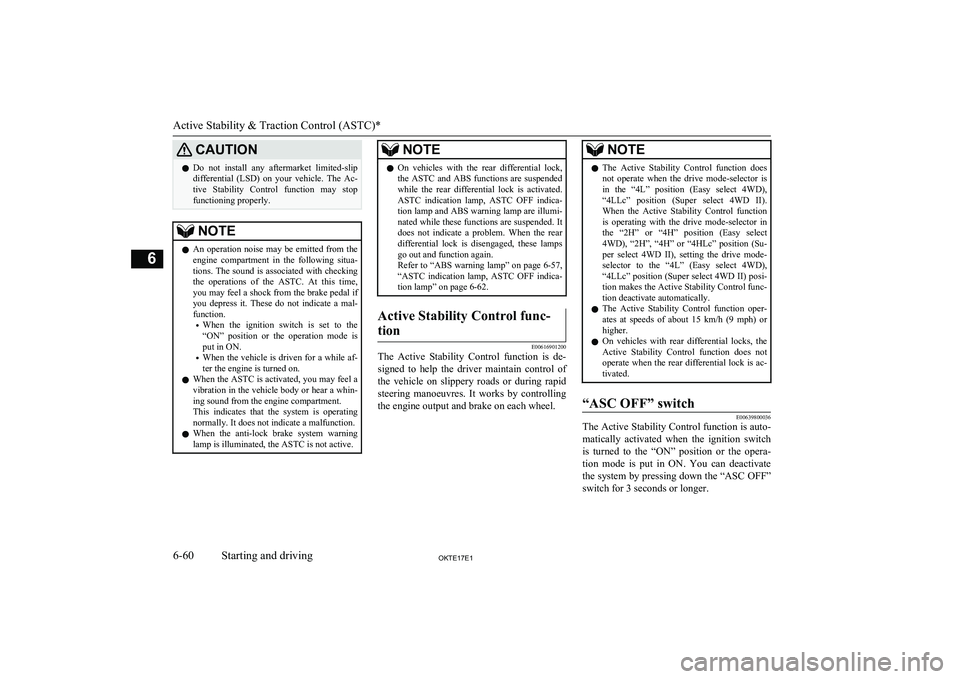
CAUTIONlDo not install any aftermarket limited-slip
differential (LSD) on your vehicle. The Ac-
tive Stability Control function may stop functioning properly.NOTEl An operation noise may be emitted from the
engine compartment in the following situa-
tions. The sound is associated with checking the operations of the ASTC. At this time,
you may feel a shock from the brake pedal if
you depress it. These do not indicate a mal- function.
• When the ignition switch is set to the
“ON” position or the operation mode is put in ON.
• When the vehicle is driven for a while af-
ter the engine is turned on.
l When the ASTC is activated, you may feel a
vibration in the vehicle body or hear a whin-
ing sound from the engine compartment.
This indicates that the system is operating normally. It does not indicate a malfunction.
l When the anti-lock brake system warning
lamp is illuminated, the ASTC is not active.NOTEl On vehicles with the rear differential lock,
the ASTC and ABS functions are suspended
while the rear differential lock is activated. ASTC indication lamp, ASTC OFF indica-
tion lamp and ABS warning lamp are illumi- nated while these functions are suspended. It
does not indicate a problem. When the rear differential lock is disengaged, these lamps
go out and function again.
Refer to “ABS warning lamp” on page 6-57,
“ASTC indication lamp, ASTC OFF indica-
tion lamp” on page 6-62.Active Stability Control func-
tion
E00616901200
The Active Stability Control function is de- signed to help the driver maintain control of the vehicle on slippery roads or during rapid
steering manoeuvres. It works by controlling the engine output and brake on each wheel.
NOTEl The Active Stability Control function does
not operate when the drive mode-selector isin the “4L” position (Easy select 4WD),“4LLc” position (Super select 4WD II).
When the Active Stability Control function
is operating with the drive mode-selector in the “2H” or “4H” position (Easy select
4WD), “2H”, “4H” or “4HLc” position (Su-
per select 4WD II), setting the drive mode- selector to the “4L” (Easy select 4WD), “4LLc” position (Super select 4WD II) posi-
tion makes the Active Stability Control func-
tion deactivate automatically.
l The Active Stability Control function oper-
ates at speeds of about 15 km/h (9 mph) or
higher.
l On vehicles with rear differential locks, the
Active Stability Control function does notoperate when the rear differential lock is ac-
tivated.“ASC OFF” switch
E00639800036
The Active Stability Control function is auto-
matically activated when the ignition switchis turned to the “ON” position or the opera-
tion mode is put in ON. You can deactivate
the system by pressing down the “ASC OFF”
switch for 3 seconds or longer.
Active Stability & Traction Control (ASTC)*
6-60OKTE17E1Starting and driving6
Page 177 of 426
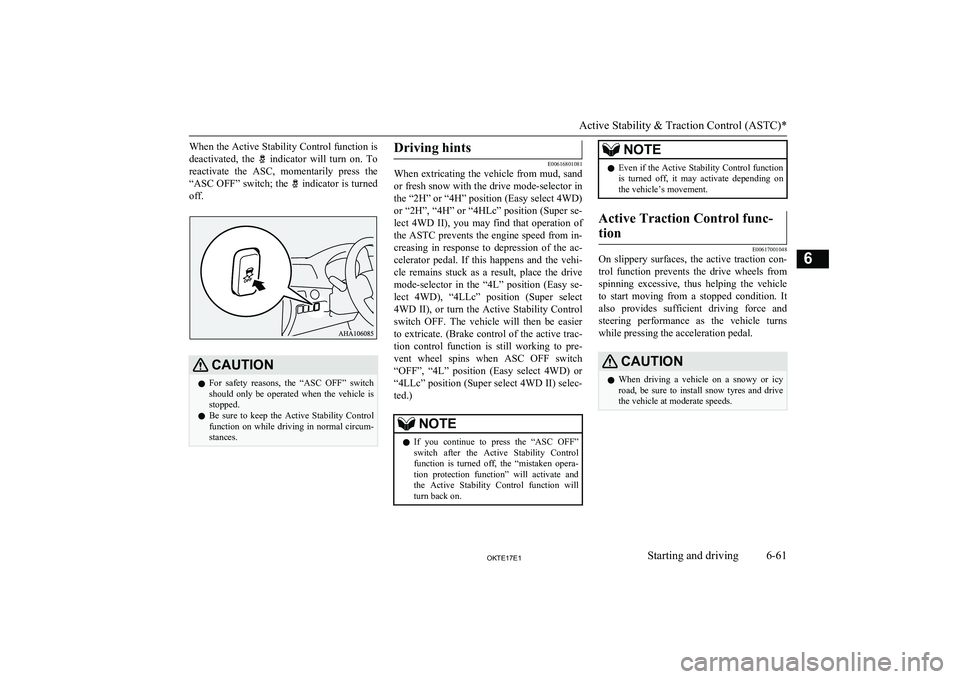
When the Active Stability Control function isdeactivated, the
indicator will turn on. To
reactivate the ASC, momentarily press the “ASC OFF” switch; the
indicator is turned
off.
CAUTIONl For safety reasons, the “ASC OFF” switch
should only be operated when the vehicle isstopped.
l Be sure to keep the Active Stability Control
function on while driving in normal circum-
stances.Driving hints
E00616801081
When extricating the vehicle from mud, sand
or fresh snow with the drive mode-selector in
the “2H” or “4H” position (Easy select 4WD) or “2H”, “4H” or “4HLc” position (Super se-
lect 4WD II), you may find that operation of
the ASTC prevents the engine speed from in- creasing in response to depression of the ac-celerator pedal. If this happens and the vehi-cle remains stuck as a result, place the drive
mode-selector in the “4L” position (Easy se- lect 4WD), “4LLc” position (Super select4WD II), or turn the Active Stability Control
switch OFF. The vehicle will then be easier
to extricate. (Brake control of the active trac- tion control function is still working to pre-
vent wheel spins when ASC OFF switch “OFF”, “4L” position (Easy select 4WD) or“4LLc” position (Super select 4WD II) selec-
ted.)
NOTEl If you continue to press the “ASC OFF”
switch after the Active Stability Control
function is turned off, the “mistaken opera- tion protection function” will activate and the Active Stability Control function will
turn back on.NOTEl Even if the Active Stability Control function
is turned off, it may activate depending on
the vehicle’s movement.Active Traction Control func-
tion
E00617001048
On slippery surfaces, the active traction con- trol function prevents the drive wheels from spinning excessive, thus helping the vehicle
to start moving from a stopped condition. It
also provides sufficient driving force and
steering performance as the vehicle turns while pressing the acceleration pedal.
CAUTIONl When driving a vehicle on a snowy or icy
road, be sure to install snow tyres and drive
the vehicle at moderate speeds.
Active Stability & Traction Control (ASTC)*
6-61OKTE17E1Starting and driving6
Page 178 of 426
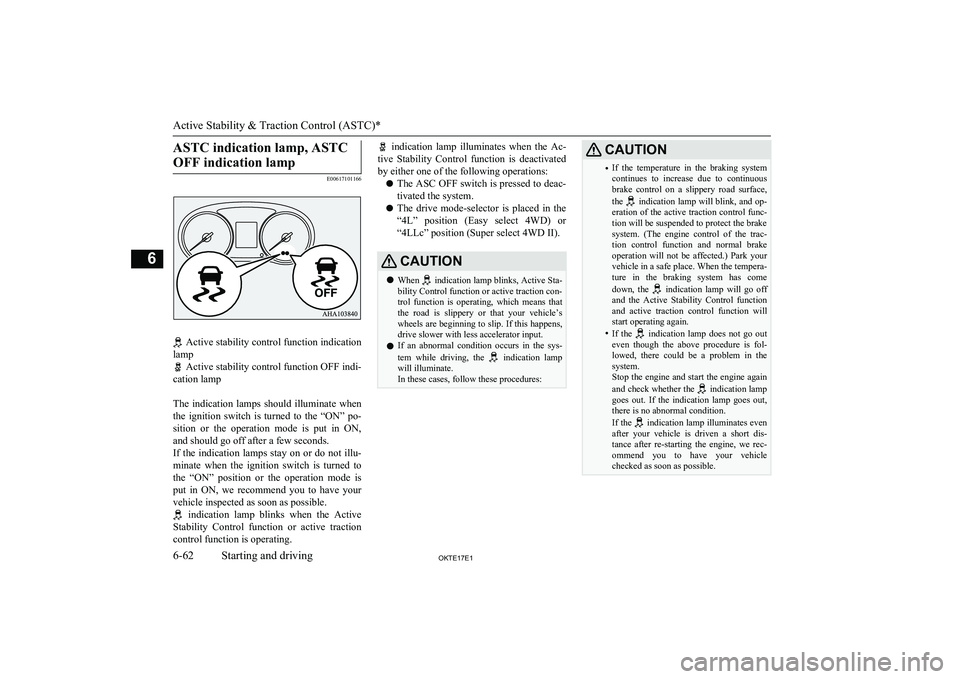
ASTC indication lamp, ASTCOFF indication lamp
E00617101166
Active stability control function indication
lamp
Active stability control function OFF indi-
cation lamp
The indication lamps should illuminate when the ignition switch is turned to the “ON” po-
sition or the operation mode is put in ON, and should go off after a few seconds.
If the indication lamps stay on or do not illu-
minate when the ignition switch is turned to the “ON” position or the operation mode is put in ON, we recommend you to have your
vehicle inspected as soon as possible.
indication lamp blinks when the Active
Stability Control function or active traction
control function is operating.
indication lamp illuminates when the Ac-
tive Stability Control function is deactivated by either one of the following operations:
l The ASC OFF switch is pressed to deac-
tivated the system.
l The drive mode-selector is placed in the
“4L” position (Easy select 4WD) or “4LLc” position (Super select 4WD II).CAUTIONl When
indication lamp blinks, Active Sta-
bility Control function or active traction con-
trol function is operating, which means that
the road is slippery or that your vehicle’s
wheels are beginning to slip. If this happens, drive slower with less accelerator input.
l If an abnormal condition occurs in the sys-
tem while driving, the
indication lamp
will illuminate.
In these cases, follow these procedures:
CAUTION• If the temperature in the braking system
continues to increase due to continuous
brake control on a slippery road surface,
the
indication lamp will blink, and op-
eration of the active traction control func-
tion will be suspended to protect the brake
system. (The engine control of the trac- tion control function and normal brake operation will not be affected.) Park yourvehicle in a safe place. When the tempera-
ture in the braking system has come
down, the
indication lamp will go off
and the Active Stability Control function and active traction control function willstart operating again.
• If the
indication lamp does not go out
even though the above procedure is fol-
lowed, there could be a problem in the system.
Stop the engine and start the engine again
and check whether the
indication lamp
goes out. If the indication lamp goes out, there is no abnormal condition.
If the
indication lamp illuminates even
after your vehicle is driven a short dis-
tance after re-starting the engine, we rec-
ommend you to have your vehicle checked as soon as possible.
Active Stability & Traction Control (ASTC)*
6-62OKTE17E1Starting and driving6
Page 179 of 426
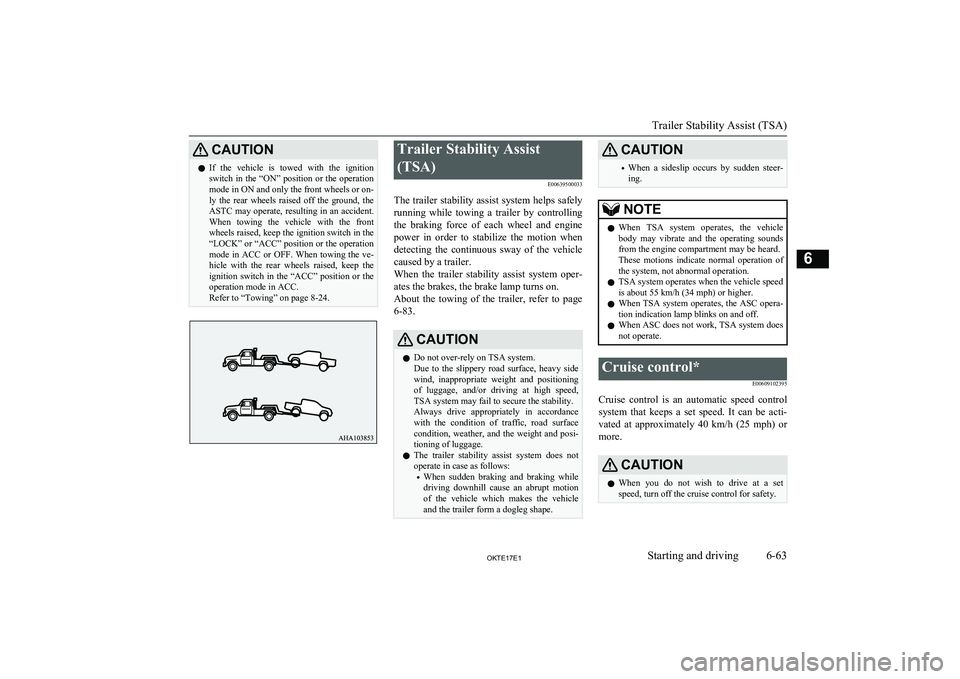
CAUTIONlIf the vehicle is towed with the ignition
switch in the “ON” position or the operation
mode in ON and only the front wheels or on- ly the rear wheels raised off the ground, the
ASTC may operate, resulting in an accident. When towing the vehicle with the front
wheels raised, keep the ignition switch in the “LOCK” or “ACC” position or the operation
mode in ACC or OFF. When towing the ve- hicle with the rear wheels raised, keep the
ignition switch in the “ACC” position or the operation mode in ACC.
Refer to “Towing” on page 8-24.Trailer Stability Assist
(TSA) E00639500033
The trailer stability assist system helps safely running while towing a trailer by controllingthe braking force of each wheel and enginepower in order to stabilize the motion when
detecting the continuous sway of the vehicle
caused by a trailer.
When the trailer stability assist system oper- ates the brakes, the brake lamp turns on.
About the towing of the trailer, refer to page 6-83.CAUTIONl Do not over-rely on TSA system.
Due to the slippery road surface, heavy side
wind, inappropriate weight and positioning
of luggage, and/or driving at high speed, TSA system may fail to secure the stability.
Always drive appropriately in accordance with the condition of traffic, road surface
condition, weather, and the weight and posi- tioning of luggage.
l The trailer stability assist system does not
operate in case as follows:
• When sudden braking and braking while
driving downhill cause an abrupt motion
of the vehicle which makes the vehicle
and the trailer form a dogleg shape.CAUTION• When a sideslip occurs by sudden steer-
ing.NOTEl When TSA system operates, the vehicle
body may vibrate and the operating sounds
from the engine compartment may be heard.
These motions indicate normal operation of
the system, not abnormal operation.
l TSA system operates when the vehicle speed
is about 55 km/h (34 mph) or higher.
l When TSA system operates, the ASC opera-
tion indication lamp blinks on and off.
l When ASC does not work, TSA system does
not operate.Cruise control*
E00609102395
Cruise control is an automatic speed controlsystem that keeps a set speed. It can be acti-vated at approximately 40 km/h (25 mph) or
more.
CAUTIONl When you do not wish to drive at a set
speed, turn off the cruise control for safety.
Trailer Stability Assist (TSA)
6-63OKTE17E1Starting and driving6
Page 180 of 426
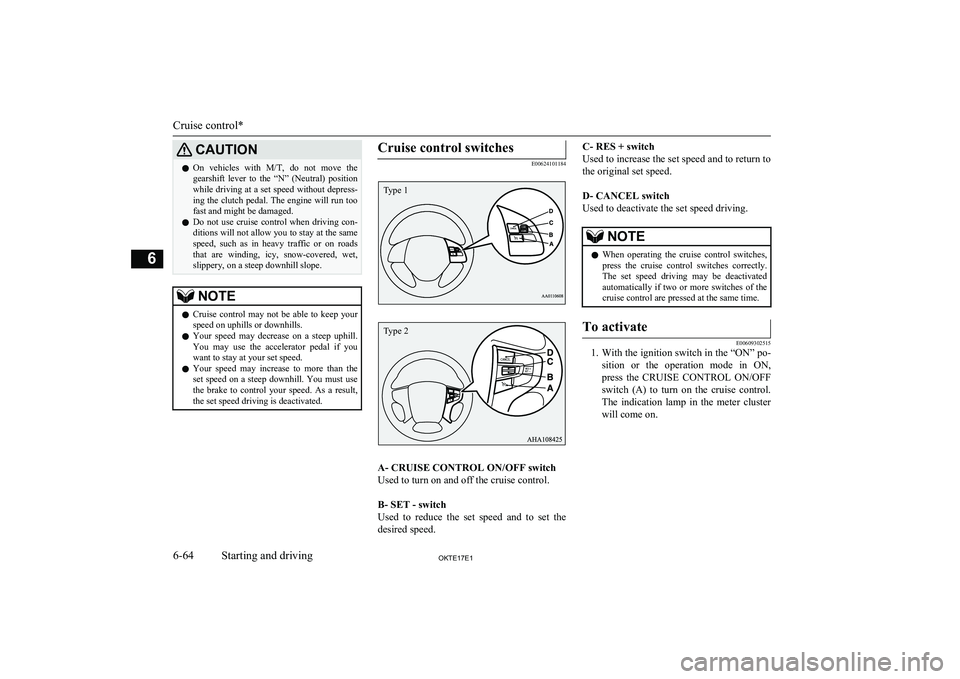
CAUTIONlOn vehicles with
M/T, do not move the
gearshift lever to the “N” (Neutral) position
while driving at a set speed without depress- ing the clutch pedal. The engine will run too
fast and might be damaged.
l Do not use cruise control when driving con-
ditions will not allow you to stay at the same
speed, such as in heavy traffic or on roads that are winding, icy, snow-covered, wet,
slippery, on a steep downhill slope.NOTEl Cruise control may not be able to keep your
speed on uphills or downhills.
l Your speed may decrease on a steep uphill.
You may use the accelerator pedal if you
want to stay at your set speed.
l Your speed may increase to more than the
set speed on a steep downhill. You must use the brake to control your speed. As a result, the set speed driving is deactivated.Cruise control switches
E00624101184
A- CRUISE CONTROL ON/OFF switch
Used to turn on and off the cruise control.
B- SET - switch
Used to reduce the set speed and to set the
desired speed.
C- RES + switch
Used to increase the set speed and to return to
the original set speed.
D- CANCEL switch
Used to deactivate the set speed driving.NOTEl When operating the cruise control switches,
press the cruise control switches correctly.
The set speed driving may be deactivated automatically if two or more switches of the
cruise control are pressed at the same time.To activate
E00609302515
1. With the ignition switch in the “ON” po-
sition or the operation mode in ON, press the CRUISE CONTROL ON/OFF
switch (A) to turn on the cruise control. The indication lamp in the meter clusterwill come on.
Cruise control*
6-64OKTE17E1Starting and driving6 Type 1 Type 2